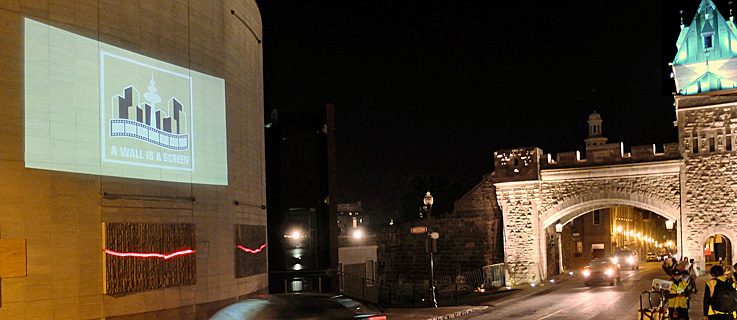On the city tours that they organise, the artists’ collective A Wall Is A Screen shows curated short films that are projected on the city walls. The interaction with the surrounding area generates commentaries on subjects such as urban development or urbanism in the public space. On the occasion of their screening on 21 September 2017 for the Festival de Cinéma de la ville de Québec, we met Sarah Adam, Sabine Horn and Peter Haueis from A Wall Is A Screen in Montreal and talked about the screening in Quebec, working in a collective and their future plans.
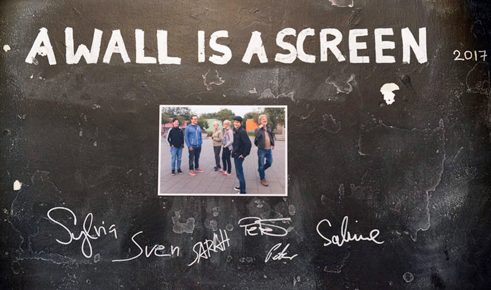 © A Wall is a Screen
How did you prepare for the screening in Québec? Were the preparations different than those for other cities? How did you choose the walls?
© A Wall is a Screen
How did you prepare for the screening in Québec? Were the preparations different than those for other cities? How did you choose the walls?
Peter Haueis: Preliminary viewings and preparations for a tour always mean a lot of walking, going into backyards, looking at the most remote corners – we really wander through the city to find the seven places where the tour will take place. We always rely, of course, on our local partners, such as Festival de Cinema de Québec in this case, to help us with the permits and tell us what will work and what will not.
Sarah Adam: We make inquiries and get the permits. One day before the screening, we do a run-through. We check the technical and content suitability of our choice in the specific locations and only then arrange the tour as it will take place. We sometimes spend an hour in one place and try different solutions.
Peter Haueis: This rehearsal enables all group members to get involved on site. We react very spontaneously to the situation that we encounter and very often change our film selection just before the actual tour. In Quebec, the preparations were somewhat more complex because we needed films with French subtitles. So in this case, we had to work even more precisely in advance than usual.
Sarah Adam: Actually we can only properly describe the event in Quebec when it’s over.
Peter Haueis: Exactly. You never know who might stumble or drive by, and what the special moments of the tour will be. One good example is a screening we had in the Hamburg subway; the film was called On a Wednesday Night in Tokyo that basically just showed people being stuffed into Tokyo subway cars during rush hour. During the screening, an Asian tourist group suddenly walked through the picture between the audience and the projection. This was quite by chance, but of course it really enhanced the event.
-
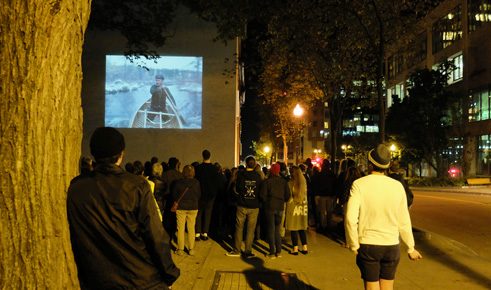 © A Wall is a Screen
© A Wall is a Screen
Screening in Quebec
-
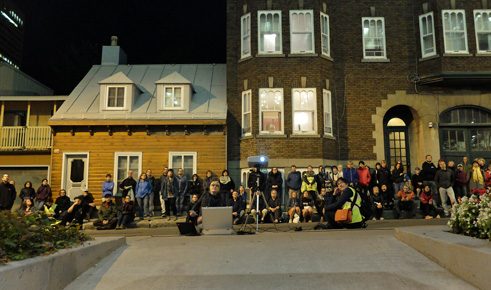 © A Wall is a Screen
© A Wall is a Screen
Audience
-
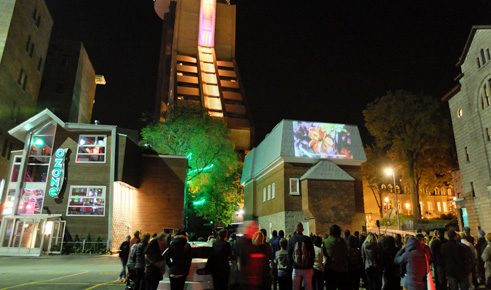 © A Wall is a Screen
© A Wall is a Screen
Screening in Quebec
-
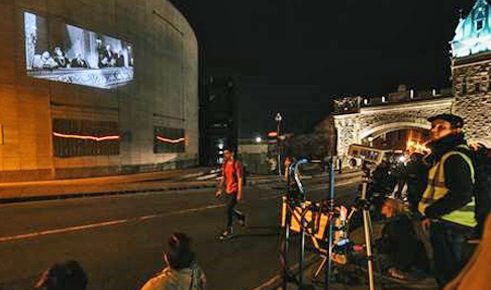 © Max-Antoine Guérin
© Max-Antoine Guérin
Screening in Quebec
-
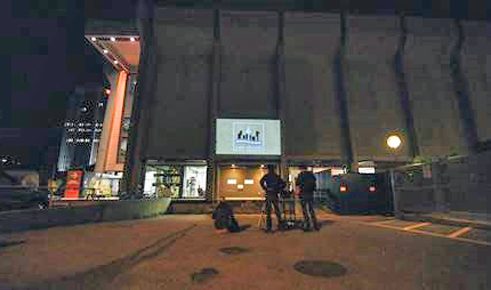 © Max-Antoine Guérin
© Max-Antoine Guérin
Preparations in Quebec
-
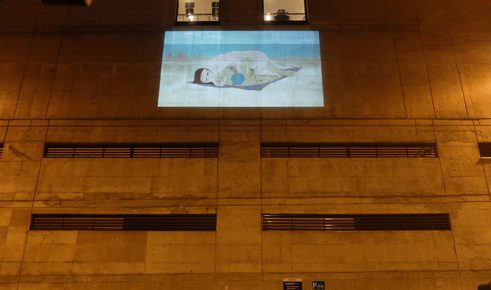 © A Wall is a Screen
© A Wall is a Screen
Screening in Quebec
-
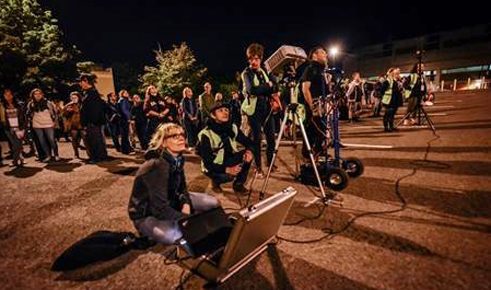 © Max-Antoine Guérin
© Max-Antoine Guérin
Sarah Adam during the screening in Quebec
A new context of film and place
Is there a comprehensive topic for the screening? What conceptual deliberations influence your decisions?
Peter Haueis: In Quebec, we don’t have a general overarching theme, although that is often the case with other festivals. This time we decided against a typical tour of the old town, and deliberately selected places beyond the tourist pathways that demand a different confrontation with the city and society. We would like to show the city from an alternative perspective and we also take a closer look at urban development processes during our tours. This is relatively abstract because it can be a general aesthetic or precise social commentary. We make sure that it doesn’t seem like we are lecturing and that all perspectives remain open. We point in one direction, but leave the interpretation to the audience. It creates a new context of film and place.
How do you choose the films, how do you compile your inventory?
Sarah Adam: We have our own database of about 900 films for which we own the rights. We always have these film files, and we have most of them in our heads. In addition, we search for relevant keywords in 40,000 short films in the database of the Kurzfilmagentur Hamburg, our local partner. When making the selection for Quebec, for example, we had to look for French-speaking films. In order to remain up-to-date and always be able to offer new films, we will go to a lot of film festivals, for example the Clermont Ferrand Festival, where many distributors present their new films.
Sabine Horn: We look at an incredible number of films, and among 100 of them there is often only one that suits us. Instead of searching for keywords, it is often more efficient to ask the people who work in the film archive.
PEOPLE ARE MORE RESERVED IN BIG CITIES
Do you notice any major differences in the audiences when you go to other countries?
Peter Haueis: The Canadian and German audiences are difficult to distinguish in a blanket way. We notice differences in particular between smaller and larger cities. Contact with the audience is easier to establish in smaller cities. People are more reserved in big cities. In Montreal and Quebec, however, we noticed a much more intensive use of the public space. Here (in Montreal), for example, there are pianos set up for passersby to play in certain places. This is certainly a difference to Western Europe and we are excited to see how it will turn out. Quebec is a smaller city with a strong cultural identity. This, too, will certainly have an impact on audience feedback.
Sabine Horn: We always take a close look at the country we are going to beforehand. In Ramallah, Palestine or India, life takes place much more on the streets. There, you have to work quite differently. It is much more difficult to organise a tour there. People stop and look, but are reluctant to enter into unknown terrain. In Eastern Europe, where we have already done a lot, we noted a great openness to art actions. Maybe that’s because there’s not much saturation there yet.
How has your collective developed since 2003?
Sabine Horn: Our work has changed considerably in fifteen years, of course. In the beginning, we were three people at the Hamburg short film festival and didn’t even plan to continue. But then we got so much positive feedback and right away the next request – from Osnabrück – so we stuck with it. Technically speaking, we have expanded considerably. We started out with a boom box that we just set up on the street. And there are twice as many of us now; we grew from three people to six. Because of our strong emphasis on a collective way of working, we have to be far more organised today.
Sarah Adam: In those fifteen years, not only we have changed, but also the technology in general. We can do our first viewing of places online now to get a first impression. Nevertheless, we place great emphasis on personally viewing the locations, but it is already helpful for preliminary planning to have the maps in street view.
Do you have a “dream project” or your “dream city” for a screening? And why?
Sarah Adam: We would really like to go to South America. We tried it a few times but it has ever worked out.
Peter Haueis: My dream would be to do something in Madagascar. There is a short film festival in the capital (Antananarivo) and the Madagascan culture of doing-it-yourself suits our way of working very well.
Sabine Horn: Don’t forget the bike tour…
Peter Haueis: Right, we always wanted to do that, too. We’ve been planning the bike tour for years. Sadly, other people are already doing that but we still want to finally implement the idea.
Next year, your collective will be celebrating its fifteenth anniversary. Are you planning anything special?
Sabine Horn: We have already done something. The Hamburg Short Film Festival rented a beautiful
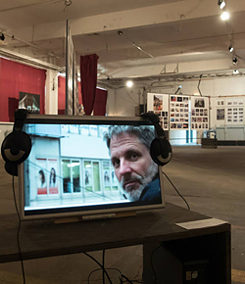 Exhibition "Nach Indien kommt Regensburg" in Hamburg
| © Sylvia Grom
Exhibition "Nach Indien kommt Regensburg" in Hamburg
| © Sylvia Grom
old hall that was going to be demolished. To make use of this hall, we celebrated our anniversary early and organised an exhibition there. From 26,000 photos of our tours, submissions, press reports and personal photos of the preparations and travels, a great collection was made called From India to Regensburg, which we showed as the finale of our fifteenth festival tour in Hamburg.
The tour organized by A Wall Is A Screen in Quebec is part of "Germany @ Canada 2017 - partners from immigration to innovation"
